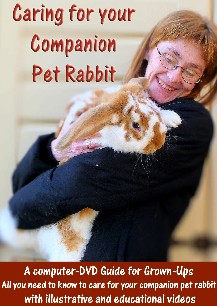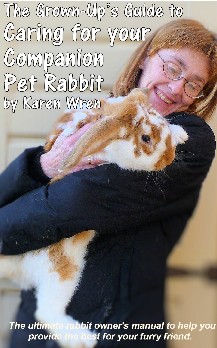This is just a summarised guide to some common medical conditions affecting rabbits. It is not a substitute for professional veterinary advice and if your bunny is showing any symptoms of illness, please see your vet as soon as possible.
Flystrike:
Fly Strike is a nasty and life-threatening condition caused by flies laying eggs on soiled skin. The eggs hatch into maggots which eat into your rabbit producing toxins which can rapidly send your rabbit into shock. There is no alternative but to remove the maggots immediately and take your rabbit to a vet surgery at once. It is also helpful to trim the fur around your bunny's bottom since this makes bathing easier and maggots can be seen more clearly. After bathing, it is vital that you towel-dry your bunny and then use a hair-dryer to ensure there is no damp flesh which provides a perfect breeding haven for further maggots.
This condition is life-threatening and urgent medical attention is essential.
Always ensure your bunny's bottom is spotless. Should it become soiled then it will need bathing. If a dirty bottom is a regular problem for your bunny this could be an indication of other illness, a dental problem, excess protein in the diet if excessive caecotrophs are being produced or your bunny might be over-weight and unable to clean him/herself fully.
Gastric Stasis
In the straight-forward case of gastric stasis caused by stress, a furball or blockage, often the first pre-symptom is a reduction of droppings in his/her litter tray and these are likely to be much smaller and drier than normal. This should set alarm bells ringing...
Rabbits, particularly youngsters under 14 weeks, are very susceptible to stress and their bodies respond to this with their digestive system shutting down due to excess adrenaline being produced. Therefore, always minimise any stresses to your bunny.
If you notice that a food bowl has barely been touched overnight or the droppings are reducing in size or number - seek advice IMMEDIATELY. At this stage, prompt treatment can save your bunny's life.
The next symptom can be dehydration which can progress rapidly, especially in warm/hot weather. Due to the blockage, your bunny loses his/her appetite, feels bloated and stops drinking and this is the first noticeable symptom. To the inexperienced bunny-keeper, the coat feels like that of a soft toy and if you pinch the scruff, it will remain tented rather than instantly spring back into place as it should do. By this stage, dehydration can be advanced especially in the gut and dried impactions will be even harder to pass. A vet can administer re-hydration fluids much more effectively than via syringe-feeding - so please take your bunny to the vet as soon as you spot any suspect symptoms. In advanced cases of dehydration, it will be very difficult to find any loose skin to pinch at the scruff as it will appear to be ‘clinging’ to the bunny's body - which will probably now be quite hard and swollen.
Our treatment methods are summarised below but, much more effective is PREVENTION RATHER THAN CURE. To help prevent stasis occurring, always feed large quantities of fresh long meadow hay (not the often stale, plastic-bagged stuffed from pet shops!). Feed adults fresh vegetables and grass and, during a moult, always pluck or comb away any shedding fur to prevent it being ingested - this grooming is required at least 1-2 times daily during a heavy moult.
The veterinary examination should include taking the bunny's temperature to check for signs of infection and examining the teeth incase the bunny has overgrown molars (spurs) which are sharply cutting into the sides of his mouth and making eating painful.
Your bunny will be uncomfortable and possibly in pain so your vet might also prescribe painkillers.
We treat straight-forward diagnosed stasis with a combination of:
* Offering greens - dandelions, dandelion leaves, parsley, grass, apples, banana - anything 'wet' (to help increase hydration and to hydrate the blockage) and high-fibre feeds such as straw, hay, ReadiGrass,
* Syringe-feeding (baby food, pellets, Critical Care solution,pro-biotic, dilute Cimicat or Lactol...) to ensure your bunny gets some nutrition during the illness
* Supreme Science Recovery solution - an excellent nutritionally complete feed for rabbits containing 19% fibre, essential nutrients and prebiotics. Even better is RecoveryPLUS which contains 22% fibre plus vitamin C, Echinacea, St Johns Wort plus chamomile for support during stress and milk thistle natural antioxidants. A wide-bore, long-teat syringe is included to make syringe-feeding easier. Recovery products are available from veterinary surgeries.
* Raw pineapple juice (contains bromelain, an enzyme which helps to break down the substance which binds fur together creating furballs)
* Some vets use liquid paraffin to help lubricate and hydrate the blockage and encourage it to move through the GI system. Furball pastes, used in moderation, can also be helpful in some cases.
* Motility stimulants ie metoclopramide and ranitidine, providing there is no blockage which can be confirmed via X-ray, to encourage gut motility to return. Ranitidine and metoclopramide, given three times daily, should be given 2 hours apart to allow time for the ranitidine to be absorbed.
* Lots of water to restore hydration. Sometimes a bunny will drink from a bowl when they refuse a bottle. If not, then syringe feeding water is essential to rehydrate a gut. Always aim the syringe towards the side of the mouth - never towards the throat as this can lead to accidental aspiration and death. Syringe water very slowly, 1ml at a time and wait until your bunny swallows before syringing any further fluid. It can be a good idea to flavour the water with pineapple juice to give it some taste and encourage your bunny to swallow.
* Infacol (available from the 'baby' counter at supermarkets or chemists), can help disperse uncomfortable gastro-intestinal wind.
* Metacam or Vetergesic for pain relief
* Saline solution given sub-cutaneously for rapid re-hydration
* Baytril (orally) to prevent GI infection
* puffy, fluid swellings around the head and face
* sores around the mouth
* swollen, 'sleepy' eyes
* swollen lips
* swellings inside the ears a
* swellings around the genital area
Within 1-2 days these swellings can increase and cause blindness.
The disease is spread by the rabbit flea which is frequently found on wild rabbits and can be transmitted by cats which come into contact with infected wild rabbits. However, is less easily spread by simple contact from one rabbit to another. If an infected rabbit shares a hutch with a healthy rabbit and neither have fleas then the disease is virtually never transmitted by contact.
The myxomatosis virus can remain dormant in the blood of fleas for several months. If it should bite a rabbit then the virus is injected into the skin as the parasite sucks blood. The virus is then transmitted to a local lymph node and enters the bloodstream enabling it to move around and multiply in the skin around the eyes, nose, face, ears and genitals. This makes eating and drinking difficult and the swelling around the eyes causes blindness - contributing to a prolonged death in some cases.
The incubation period is 5-14 days. Some infected rabbits may survive for weeks while a more severely infected rabbit could succumb within 12 days. Very few wild rabbits will survive although pet rabbits with dedicated owners can recover if they are intensively nursed, fed and watered and given antibiotics to prevent pneumonia. Recovery can take weeks or months and scarring, scaling and scabbing can persist on the head and body. Prevention is always better than cure and the spread of myxomatosis can be prevented or the risks minimised by:
* ensuring wild animals, and animals which might come into contact with wild animals/rabbits, do not come into contact with pet rabbits
* controlling fleas - using sprays, dips, UV fly zappers and insect repellant strips
* ensuring bedding is always kept dry to avoid attracting mosquitoes
* vaccination with the Nobivac combined Myxo/RHD vaccine.
Vaccination can give good immunity but no vaccination can offer a complete 100% guarantee of protection. Some rabbits may be immunologically incompetent and fail to respond the vaccination. If a vaccinated bunny should contract myxomatosis, then they tend to develop an 'atypical' and milder form of the disease which is not usually fatal. Provided they receive appropriate nursing, symptomatic treatment and support then they will usually survive (possibly with scarring). Treatments could include antibiotics to prevent pneumonia, vitamins, pro/prebiotics to boost general condition, steam/eucalyptus inhalations to aid breathing (popping the patient into a pet carrier and covering it is a good way to provide these) along with any necessary topical treatments to the scars, lumps and bumps which may develop and other treatments for any other symptoms which may develop.
Pasteurella infections are amongst the most common afflicting pet rabbits. Pasteurellosis can cause 'snuffles' - sneezing, coughing, nasal discharge, chronic sinusitis and chronic infection can lead to peritonitis, metritis, mastitis, otitis media, abscesses and pneumonia.
It is a common infection and many, apparently healthy rabbits will carry the bacteria but display no symptoms of infection. However, a bunny with an impaired immune system can develop a chronic form of infection. In many cases, the rabbit will continue to carry on with its daily life, eating and drinking normally, but wiping its nose on its paw after sneezing - and this matted fur can be one of the first indications of the disease.
Veterinary attention is required together with a course of antibiotic treatment although effectiveness can be limited to controlling rather than completely eliminating the infection. Secondary infections can prove fatal.
VHD(1)
VHD refers to Viral Haemorrhagic Disease. It was first reported in the UK in 1992 and has since spread throughout Britain. VHD is easily transmitted between rabbits or via contaminated food, bedding, hutches, birds or transmitted via owners. The virus can survive on shoes or clothing for 3 months so it is very easy for humans to become carriers without being aware of it. Generally, it affects rabbits aged over 10 weeks.
Symptoms include:
* loss of appetite
* nose bleeding
* breathing difficulties
The disease progresses rapidly and death usually occurs within 2 days, often without warning. In its acute form, it can be most distressing as blood clots develop on the lungs rendering the rabbit unable to breathe. There is no cure but protection is available via vaccination using vaccines such as Lapinject or the newer (2012) combined Myxo/RHD vaccine.
VHD2/RHD2
In 2016, a mutated form of the VHD virus was identified in UK, known as VHD2 or RHD2. It is similar to VHD1 (above) and a range of new vaccines, such as Filavac RHD were licensed for use in the UK from summer 2017, although these have now been largely replaced by Nobivac Myxo-RHD Plus.
A new combiined triple vaccine was launched in the UK in 2020, Nobivac Myxo-RHD Plus which combines the myxomatosis, VHD1 and VHD2 vaccines into one annually-administered vaccination from 5 weeks of age.


